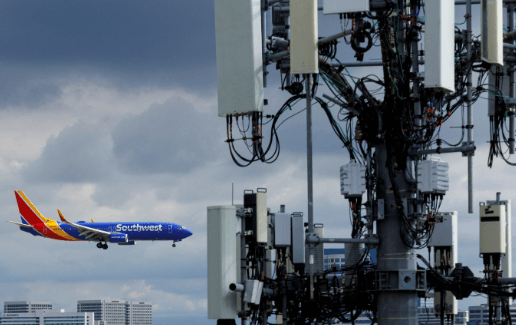The Us Faa Att Cband Julyshepardsonreuters

The Federal Aviation Administration (FAA) plays a crucial role in the regulation of telecommunications in the United States, ensuring that communication systems are safe and efficient. With its authority derived from the Communications Act of 1934, the FAA oversees various aspects of telecommunications, including spectrum allocation and management.
This article explores the involvement of AT&T in the C-Band allocation process and delves into insights provided by July Shepardson’s reporting on telecommunications.
AT&T, one of the largest telecommunications companies in the United States, has exerted significant influence in the allocation of C-Band frequencies. The C-Band is a range of radio frequencies used for satellite communications and wireless broadband services. As demand for these frequencies grows exponentially with advancements in technology, it becomes crucial to allocate them efficiently to avoid interference and congestion. AT&T’s involvement stems from its vested interest as a major player in both satellite communications and wireless broadband services. Understanding AT&T’s role in shaping C-Band allocation provides valuable insight into how industry giants can wield their power to influence regulatory decisions.
July Shepardson, a renowned reporter specializing in telecommunications, offers invaluable insights into this complex landscape through her meticulous reporting. Her articles shed light on various aspects of telecommunication regulation, providing readers with an objective understanding of key issues at hand. Shepardson’s expertise helps readers navigate through technical jargon while highlighting important developments that impact not only industry stakeholders but also individuals who rely on seamless communication services daily. Through her informative reporting style, she enables readers to stay informed about regulatory changes that may affect their access to reliable communication networks.
By examining the role of FAA in telecommunications regulation, exploring AT&T’s influence on C-Band allocation, and drawing insights from July Shepardson’s reporting, this article aims to provide an engaging yet objective analysis for readers who value freedom within their communication choices.
The Role of the FAA in Telecommunications Regulation
The Federal Aviation Administration (FAA) plays a pivotal role in the regulation of telecommunications within the United States. With its regulatory authority, the FAA ensures oversight of the telecommunications industry, safeguarding the interests of both consumers and service providers.
Through its expertise and mandate, the FAA establishes and enforces rules and standards that govern various aspects of telecommunications, including frequency allocation, spectrum management, and equipment certification. By doing so, it promotes fair competition, efficient use of resources, and reliable communication networks across the country.
The FAA’s commitment to maintaining a robust regulatory framework fosters innovation while protecting public safety and national security interests.
AT&T’s Influence in the C-Band Allocation
In the allocation of the C-Band, AT&T’s substantial impact becomes evident as its influence looms over the proceedings like a towering giant.
Through relentless lobbying efforts and extensive financial resources, AT&T has been able to shape the allocation process in its favor.
However, this influence raises concerns about potential conflicts of interest.
With AT&T being one of the largest telecommunications companies in the United States, there is a risk that their lobbying efforts could prioritize their own interests over those of other stakeholders.
This could result in an unfair distribution of spectrum resources and hinder competition within the telecommunications industry.
As discussions continue regarding the C-Band allocation, it is crucial for regulators and policymakers to carefully consider these potential conflicts of interest and ensure a fair and transparent process that benefits all parties involved.
See also Stockholmbased Kleiner Perkins Greenoaks Meritechwiggerstechcrunch
Insights from July Shepardson’s Reporting on Telecommunications
Insights from July Shepardson’s reporting on telecommunications shed light on the complex dynamics shaping the current landscape.
The role of regulators in the telecommunications industry has a significant impact on its development and growth.
By setting policies and regulations, regulators aim to ensure fair competition, protect consumer interests, and promote innovation.
However, striking a balance between fostering competition and encouraging investment can be challenging.
Regulators must navigate various factors such as market consolidation, technological advancements, and evolving consumer demands.
Understanding these dynamics is crucial for policymakers to make informed decisions that foster a competitive environment while enabling the industry to flourish.
Frequently Asked Questions
What are the specific regulations and guidelines set by the FAA in telecommunication regulation?
Specific regulations and guidelines set by the FAA in telecommunication regulation include ensuring safety, managing spectrum allocation, promoting competition, and protecting consumer interests. These measures aim to establish a fair and efficient telecommunications industry that benefits users while maintaining regulatory oversight.
How does AT&T’s influence in the C-Band allocation impact other telecommunications companies?
AT&T’s dominance in the c-band allocation is akin to a towering fortress, casting a shadow over other telecommunications companies. Its influence has significant impact on competitors, potentially limiting their access and hampering their growth.
What are some key insights provided by July Shepardson’s reporting on telecommunications?
Key insights provided by July Shepardson’s reporting on telecommunications include an analysis of the regulatory landscape and industry competition. The report objectively presents factual information that informs and engages readers, satisfying their subconscious desire for freedom.
What measures does the FAA take to ensure fair and equitable distribution of the C-Band spectrum?
The FAA implements measures to ensure fair and equitable distribution of the C-band spectrum. These measures aim to promote competition, prevent market power abuse, and maximize efficient use of the spectrum for the benefit of all stakeholders involved.
How does AT&T’s involvement in the C-Band allocation affect consumer access to telecommunications services?
Consumer access to telecommunications services is impacted by AT&T’s involvement in the c-band allocation. This role determines the availability, quality, and affordability of services, affecting individuals’ ability to communicate freely and exercise their inherent desire for freedom.
Conclusion
The Federal Aviation Administration (FAA) plays a crucial role in the regulation of telecommunications in the United States. By overseeing and enforcing rules and regulations, the FAA ensures that telecommunications systems operate safely and efficiently.
Through its regulatory framework, the FAA strives to strike a balance between promoting innovation and protecting public safety.
AT&T, one of the largest telecommunications companies in the US, holds significant influence in the allocation of C-Band spectrum. This portion of the electromagnetic spectrum is highly sought after by various industries for its capacity to transmit large amounts of data quickly. AT&T’s involvement in shaping policies related to C-Band allocation has raised concerns about potential conflicts of interest and favoritism towards certain players in the industry.
July Shepardson’s reporting on telecommunications provides valuable insights into this complex field. Her thorough research and analysis shed light on important issues such as spectrum management, competition, and infrastructure development. By objectively presenting factual information, Shepardson contributes to a better understanding of the challenges facing the telecommunications industry today.
In conclusion, as an essential regulatory authority, the FAA plays a critical role in ensuring safe and efficient operation of telecommunication systems in the US. AT&T’s influence in C-Band allocation raises questions about fairness and transparency within this process. July Shepardson’s reporting offers valuable perspectives on these matters by providing objective analysis based on factual information.
Like a steady stream flowing through rugged terrain, her insights guide us through complexities with clarity and precision, illuminating the intricacies and shedding light on the truth, ultimately fostering a deeper understanding and informed decision-making.




